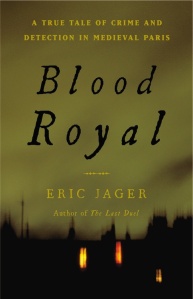Adventures in True Crime, Part One
Why are we drawn to true crime narratives? The ready-to-hand answer to this question might be that we are by nature prurient creatures whose morbid curiosity can only be slaked by the rich helpings of horror and misfortune served up by these stories. While there may be some truth to this explanation, I don’t believe that it is the whole truth.
I was recently asked by my friend and fellow Usual Suspect Pauline if I might be interested in teaching a course in the literature of true crime. The course would be offered at a lifelong learning institute that has a local campus. (Pauline herself has been teaching there for a number years.) As soon as this proposition was put before me, my mind started to race: The Suspicions of Mr Whicher! Fatal Vision! The Executioner’s Song! The Devil in the White City! Midnight in Peking! The Poisoner’s Handbook! And, inevitably, In Cold Blood.

Truman Caopte in the Clutter home. The starkness of the surroundings seems to emphasize the horror and pathos of what took place there.
In addition to these, in the past several months I’ve read three notable true crime titles: Little Demon in the City of Light by Steven Levingston, The Mad Sculptor by Harold Schechter, and Blood Royal by Eric Jager. All three belong to the subgenre of historical true crime and though all were in varying degrees engrossing. I’d have to say that my favorite was Blood Royal, a book that combines elements of medieval history, crime, and detection to create a riveting narrative. It will rank as one of my best reads of this year, for certain.
So my mind is racing, filled with the myriad possibilities and approaches to such an undertaking, not to mention the sheer number of books to consider. For the first time, the vastness of the field became apparent to me. Where to begin? How to place limits?
With Pauline’s help, I eventually settled on a book to use in the (prospective) course: 
With this decision made, everything else began to fall more or less neatly into place.
to begin with, I decided to highlight several of the 20th century’s more notorious crimes, as referenced in this collection.. There’s “The Black Dahlia,” subject of an essay written by Jack Webb. Yes, that Jack Webb, the man who created Dragnet and became a pioneer of realism in television police dramas.
************************************
In “Eternal Blonde,” Damon Runyon describes the murder trial of former lovers Ruth Snyder and Judd Gray. In the heat of their affair, Snyder convinced Gray to help kill her husband for the insurance money. They had to make it look like an accident, so that they could get twice the amount in the payout. In insurance speak, that’s called double indemnity.
Sound familiar? It should:
Double Indemnity , a classic noir novel, was inspired by the Snyder-Gray case. In 1944, it became one of the greatest noir films ever made. The following clip, featuring Fred MacMurray and Barbara Stanwyck, is one of the movie’s most memorable scenes. The screenwriter was Raymond Chandler, and the rapid fire one liners were written by him, not Cain:
************************************
In the fifties and sixties, Dorothy Kilgallen was a panelist on a popular television quiz show called What’s My Line. Most of us who watched the show back then knew her only in that capacity. She was in fact an accomplished journalist who write about show business as well as politics and crime. Her piece in the True Crime anthology is called “Sex and the All-American Boy,” and all I can say is, read it for yourself. Tone, style, content – she absolutely nails it!
The eponymous all-American boy is one Robert Allen Edwards. In 1934 Robert found himself embroiled in a classic love triangle. The competing love interests were Freda McKechnie, the girl next door in Edwardsville, Pennsylvania, and Margaret Crain, who resided with her parents in Aurora, New York. Freda became pregnant. Robert said he’d marry her, but he desperately did not want to.
One evening, Freda suggested that Robert take her to a lake for a swim….
A young man with two girlfriends. One of them becomes pregnant and insists that they marry. They go down to a nearby lake….
Once again, I ask: Sound familiar? It is almost the exact same scenario that describes the death of Grace Brown at the hands of Chester Gillette in upstate New York in 1906. One of the journalists present at the murder trial of Robert Allen Edwards was Theodore Dreiser. In 1925, Dreiser had written his magnum opus An American Tragedy, a fictional treatment of the Brown/Gillette story. How strange it must have seemed to him, sitting in that courtroom some twenty years later. He probably experienced a powerful sense of déja vu.
An American Tragedy provided the plot line for yet another terrific film. Made in 1951, A Place in the Sun starred Montgomery Clift, Shelley Winters and a 17-year-old Elizabeth Taylor.
******************************
More on this subject will appear in a subsequent post. Now I’d like to address the way in which this subject has hijacked my personal reading program! Having promised myself that in future, I’d be buying as few hard copy books as possible, I’ve just purchased a slew of them. Several of the items I’ve become interested in as a result of my recent research on true crime are not owned by the local library; nor are they available for Kindle download.
A number are out of print. This is true of Murder One, the collection of pieces by Dorothy Kilgallen that includes “Sex and the All-American Boy.”  I did not get this Dell paperback (75 cents!); rather, I got a used hardback. Rather ill-used, judging from the condition of its cover.
I did not get this Dell paperback (75 cents!); rather, I got a used hardback. Rather ill-used, judging from the condition of its cover.
 Blood and Ink: An International Guide to Fact Based Crime Literature, by Albert Borowitz. In print, published by Kent Stat University Press. A terrific but dangerous reference work. I was only in the A’s when I encountered Richard Altick, an author I remembered from my graduate school days. At that time, we’d been assigned to read The Scholar Adventurers. I recall finding Altick’s tales of literary sleuthing quite fascinating. What I don’t recall, and perhaps never knew, is that he had a special interest in Victorian Britain, specifically in crimes that occurred in that era.
Blood and Ink: An International Guide to Fact Based Crime Literature, by Albert Borowitz. In print, published by Kent Stat University Press. A terrific but dangerous reference work. I was only in the A’s when I encountered Richard Altick, an author I remembered from my graduate school days. At that time, we’d been assigned to read The Scholar Adventurers. I recall finding Altick’s tales of literary sleuthing quite fascinating. What I don’t recall, and perhaps never knew, is that he had a special interest in Victorian Britain, specifically in crimes that occurred in that era. 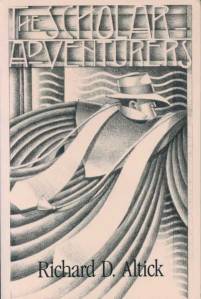
 Hence, my ordering of Deadly Encounters: Two Victorian Sensations (available for Kindle download, thank goodness). No more poking around in Blood and Ink for me – at least, for the present! (“The Medea of Kew Gardens Hills” by Albert Borowitz is included in the True Crime anthology.)
Hence, my ordering of Deadly Encounters: Two Victorian Sensations (available for Kindle download, thank goodness). No more poking around in Blood and Ink for me – at least, for the present! (“The Medea of Kew Gardens Hills” by Albert Borowitz is included in the True Crime anthology.)
And today I look forward to the arrival of two more items related to my true crime investigations. The first is The Badge by Jack Webb. Webb’s essay on the Black Dahlia murder case is included in this volume. 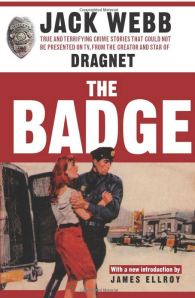 I’m especially interested in reading James Ellroy’s introduction to the 2005 reissue of this book. In 1958, when he was ten years old, Ellroy’s mother was murdered. He then went to live with his father, something he was glad to do, as that feckless person pretty much left him alone to raise himself and later, to run wild. One thing his father did do for him was to give him the Jack Webb book for his eleventh birthday. On the face of it, this would seem an odd gift to give to a boy whose mother had recently met with violent death. And yet the book had a life changing effect on him, particularly the piece on the Black Dahlia:
I’m especially interested in reading James Ellroy’s introduction to the 2005 reissue of this book. In 1958, when he was ten years old, Ellroy’s mother was murdered. He then went to live with his father, something he was glad to do, as that feckless person pretty much left him alone to raise himself and later, to run wild. One thing his father did do for him was to give him the Jack Webb book for his eleventh birthday. On the face of it, this would seem an odd gift to give to a boy whose mother had recently met with violent death. And yet the book had a life changing effect on him, particularly the piece on the Black Dahlia:
The Badge got me hooked. I just followed Jack Webb’s lead.
He credits the book with motivating him to become, in his own words, the “Demon Dog of American literature.”
Ellroy’s essay “My Mother’s Killer” is included in the True Crime anthology. Originally published in GQ in 1994, the piece was later enlarged to become the memoir My Dark Places, published in 1996.
Jean Hilliker Ellroy’s killer. most probably the “swarthy man” with whom she’d gone out on a date the night of her death, has never been found.
Oh, and the second item expected in today’s delivery, originally published in 1919, is this: 
I’ll keep you posted on further developments.
Roberta recommends: June 2014
Tuesday night I had the privilege of representing AAUW Readers at a gathering of our members. Each committee and/or affinity group selects a table on which to display relevant items. I of course schlepped many books, thereby getting my day’s exercise (more like my week’s exercise!). In the course of gathering the books for display, I began a list to go with them. It’s an annotated list, something I’m usually too lazy to do, but I made it a bit easier for myself this time by cribbing shamelessly from my own previous posts in this space and, in several cases, quoting other reviewers.
Herewith, in a somewhat altered and enlarged format, are the results of my efforts, which I hope you enjoy:
 The Round House by Louise Erdrich. A Native American teenager is determined to find out the truth about an unprovoked attack on his mother. By turns funny and poignant, the novel illustrates, with grace and subtlety, the process by which a boy becomes a man.
The Round House by Louise Erdrich. A Native American teenager is determined to find out the truth about an unprovoked attack on his mother. By turns funny and poignant, the novel illustrates, with grace and subtlety, the process by which a boy becomes a man.
 Clever Girl by Tessa Hadley. “Although this novel has its share of unanticipated twists and turns, it is not by and large highly dramatic. Hadley’s writing is not showy, but in her choice of words, she has an almost pointillist gift for precision.”
Clever Girl by Tessa Hadley. “Although this novel has its share of unanticipated twists and turns, it is not by and large highly dramatic. Hadley’s writing is not showy, but in her choice of words, she has an almost pointillist gift for precision.”

 They Were Counted by Miklos Banffy, first volume in The Transylvanian Trilogy. “At 1,454 pages, ‘The Transylvanian Trilogy’ is worth every penny. Set during the last years of the Austro-Hungarian Empire, when Europe as a whole is slipping toward a cataclysmic war, it’s a saga of shortsighted politics and illicit love, of progressivism at loggerheads with entrenched interests, of servants outfoxing their masters — all kept in breathtaking balance by the power of the author’s artistry.” Dennis Drabelle in the Washington Post
They Were Counted by Miklos Banffy, first volume in The Transylvanian Trilogy. “At 1,454 pages, ‘The Transylvanian Trilogy’ is worth every penny. Set during the last years of the Austro-Hungarian Empire, when Europe as a whole is slipping toward a cataclysmic war, it’s a saga of shortsighted politics and illicit love, of progressivism at loggerheads with entrenched interests, of servants outfoxing their masters — all kept in breathtaking balance by the power of the author’s artistry.” Dennis Drabelle in the Washington Post

 The Last Duel: A True Story of Crime, Scandal, and Trial by Combat in Medieval France; and Blood Royal: A True Tale of Crime and Detection in Medieval Paris, both by Eric Jager. I thought that the history of the Middle Ages could not be made more riveting than it was in The Last Duel. And then I read Blood Royal, the story of the murder of the king of France’s brother and the ensuing investigation, and it was even better!
The Last Duel: A True Story of Crime, Scandal, and Trial by Combat in Medieval France; and Blood Royal: A True Tale of Crime and Detection in Medieval Paris, both by Eric Jager. I thought that the history of the Middle Ages could not be made more riveting than it was in The Last Duel. And then I read Blood Royal, the story of the murder of the king of France’s brother and the ensuing investigation, and it was even better!
 Glittering Images: A Journey Though Art from Egypt to Star Wars by Camille Paglia. This author is well known for stoking controversy in other fields, but art history is her vocation as well as her passion, and she writes about it with the same articulate intensity that she brings to her writing about social and political hot button issues.
Glittering Images: A Journey Though Art from Egypt to Star Wars by Camille Paglia. This author is well known for stoking controversy in other fields, but art history is her vocation as well as her passion, and she writes about it with the same articulate intensity that she brings to her writing about social and political hot button issues.
 The Land of Dreams by Vidar Sundstol. “This is a beautiful book. The characters are memorable and intriguing, but what has really stayed with me is Sundstøl’s remarkable evocation of a place I previously knew nothing about. In writing that is intensely lyrical, he has made Minnesota’s North Shore come alive.”
The Land of Dreams by Vidar Sundstol. “This is a beautiful book. The characters are memorable and intriguing, but what has really stayed with me is Sundstøl’s remarkable evocation of a place I previously knew nothing about. In writing that is intensely lyrical, he has made Minnesota’s North Shore come alive.”
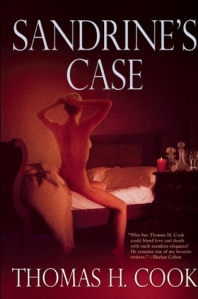 Sandrine’s Case by Thomas H. Cook. This is a thoroughly engrossing and terrifically well written courtroom drama, but “….the greatest strength of the novel lies in its exploration of one person’s mind and heart, in its depiction of what the truth really consists of, and how, once that truth stands revealed, it has the power to alter a person’s most basic assumptions about the world, about other people, and most of all, about him- or herself.”
Sandrine’s Case by Thomas H. Cook. This is a thoroughly engrossing and terrifically well written courtroom drama, but “….the greatest strength of the novel lies in its exploration of one person’s mind and heart, in its depiction of what the truth really consists of, and how, once that truth stands revealed, it has the power to alter a person’s most basic assumptions about the world, about other people, and most of all, about him- or herself.”
 A Fatal Inversion by Barbara Vine/Ruth Rendell. “The theme of expulsion from the garden of Eden resonates from time to time in this novel. But in the Bible, a right to be present in that blessed place is premised on the possession of an innocent and unsullied nature. Alas, none of these protagonists were possessed of such a nature. They were deeply flawed human beings, before the terrible unraveling ever began.” This bids fair to be the best novel of psychological suspense I’ve ever read.
A Fatal Inversion by Barbara Vine/Ruth Rendell. “The theme of expulsion from the garden of Eden resonates from time to time in this novel. But in the Bible, a right to be present in that blessed place is premised on the possession of an innocent and unsullied nature. Alas, none of these protagonists were possessed of such a nature. They were deeply flawed human beings, before the terrible unraveling ever began.” This bids fair to be the best novel of psychological suspense I’ve ever read.
 A Dark Anatomy by Robin Blake. Set in Preston, Lancashire, in the year 1740, this novel’s chief protagonist is Titus Cragg, who serves as the town’s coroner. He is greatly helped in his endeavors by Luke Fidelis, a young physician and also a close friend. (Titus is married; Luke is not.) A Dark Anatomy is distinguished by a meticulous re-creation of a very specific time and place as well as a fully realized cast of characters. For my money, it’s the best historical mystery series debut to come along in quite some time.
A Dark Anatomy by Robin Blake. Set in Preston, Lancashire, in the year 1740, this novel’s chief protagonist is Titus Cragg, who serves as the town’s coroner. He is greatly helped in his endeavors by Luke Fidelis, a young physician and also a close friend. (Titus is married; Luke is not.) A Dark Anatomy is distinguished by a meticulous re-creation of a very specific time and place as well as a fully realized cast of characters. For my money, it’s the best historical mystery series debut to come along in quite some time.
 Cop To Corpse by Peter Lovesey. This time, for Peter Diamond, it’s personal: while on routine patrol, Harry Tasker, a young beat cop, has been shot and killed by a sniper. Chief Superintendent Diamond must bring the full force of his investigative acumen to bear on one of the most baffling cases he’s ever encountered. ”Since its inception, with The Last Detective in 1991, the Peter Diamond series has gotten better and better….I owe many hours of great reading pleasure to Peter Lovesey. His procedurals are on a par with those of Reginald Hill and Colin Dexter.”
Cop To Corpse by Peter Lovesey. This time, for Peter Diamond, it’s personal: while on routine patrol, Harry Tasker, a young beat cop, has been shot and killed by a sniper. Chief Superintendent Diamond must bring the full force of his investigative acumen to bear on one of the most baffling cases he’s ever encountered. ”Since its inception, with The Last Detective in 1991, the Peter Diamond series has gotten better and better….I owe many hours of great reading pleasure to Peter Lovesey. His procedurals are on a par with those of Reginald Hill and Colin Dexter.”
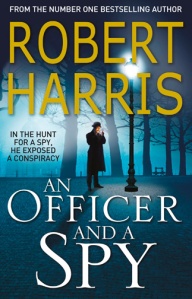 An Officer and a Spy by Robert Harris. A vivid retelling of France’s notorious Dreyfus Affair by a master of the historical thriller. “While finely attuned to modern resonances of surveillance, cultural identity and patriotic loyalty, Harris stays true to the atmosphere and morals of the period. He has crafted a compelling narrative of state corruption and individual principle, and a memorable whistleblower whose stubborn call can still be heard more than a century later.” Andrew Anthony in The Guardian/Observer
An Officer and a Spy by Robert Harris. A vivid retelling of France’s notorious Dreyfus Affair by a master of the historical thriller. “While finely attuned to modern resonances of surveillance, cultural identity and patriotic loyalty, Harris stays true to the atmosphere and morals of the period. He has crafted a compelling narrative of state corruption and individual principle, and a memorable whistleblower whose stubborn call can still be heard more than a century later.” Andrew Anthony in The Guardian/Observer

Alfred Dreyfus (second from right) on his release in 1906 from Devil’s Island where he had been wrongfully imprisoned since 1895. Photograph: Collect/Martin Argles
And for those who love Italy, as I do:
 Temporary Perfections by Gianrico Carofiglio. “This is not a plot driven novel. Its richness lies in its character creation, vivid sense of place – the place being the city of Bari, in Italy’s Puglia region – and terrific writing. Temporary Perfections is the fourth in the Guido Guerrrieri series….I plan to go back and read the other Guerrieri novels. I absolutely love this book!” (I also recommend, and highly, The Silence of the Wave.)
Temporary Perfections by Gianrico Carofiglio. “This is not a plot driven novel. Its richness lies in its character creation, vivid sense of place – the place being the city of Bari, in Italy’s Puglia region – and terrific writing. Temporary Perfections is the fourth in the Guido Guerrrieri series….I plan to go back and read the other Guerrieri novels. I absolutely love this book!” (I also recommend, and highly, The Silence of the Wave.)
 A Venetian Affair: A True Tale of Forbidden Love in the Eighteenth Century, by Andrea di Robilant. A cache of letters found in a Venetian palazzo proves to be a treasure chest for this Italian journalist. With the aid of these precious documents, di Robilant is able to track back the history of his own family. In the process, he unearths a beautiful love story set against the grandeur and intrigue of eighteenth century Venice.
A Venetian Affair: A True Tale of Forbidden Love in the Eighteenth Century, by Andrea di Robilant. A cache of letters found in a Venetian palazzo proves to be a treasure chest for this Italian journalist. With the aid of these precious documents, di Robilant is able to track back the history of his own family. In the process, he unearths a beautiful love story set against the grandeur and intrigue of eighteenth century Venice.
 The Golden Egg, and pretty much all the Commissario Guido Brunetti novels by Donna Leon. “I very much like the use Leon makes in these novels of the third person limited point of view. It has allowed her readers over the years to attain a kind of intellectual and emotional intimacy with Guido Brunetti….Likewise, the reader gets to spend time en famille with Brunetti, Paola, and their two children, Chiara and Raffi. This is a close and devoted family. Meals are taken together, including lunch – including on weekdays – very civilized. The meals are invariably delicious; Paola is a terrific cook. The conversation at table is often both bracing and raucous.”
The Golden Egg, and pretty much all the Commissario Guido Brunetti novels by Donna Leon. “I very much like the use Leon makes in these novels of the third person limited point of view. It has allowed her readers over the years to attain a kind of intellectual and emotional intimacy with Guido Brunetti….Likewise, the reader gets to spend time en famille with Brunetti, Paola, and their two children, Chiara and Raffi. This is a close and devoted family. Meals are taken together, including lunch – including on weekdays – very civilized. The meals are invariably delicious; Paola is a terrific cook. The conversation at table is often both bracing and raucous.”
 Poets in a Landscape by Gilbert Highet. Born in Glasgow Scotland in 1906, Gilbert Highet taught the classics at Columbia University from 1938 to 1971. During that time, his charismatic classroom presence became legendary. Poets in a Landscape is part history, part travelogue, and wholly magical. Every page is animated by Highet’s deep knowledge and love of Italy, both past and present….From start to finish, a transcendent reading experience.”
Poets in a Landscape by Gilbert Highet. Born in Glasgow Scotland in 1906, Gilbert Highet taught the classics at Columbia University from 1938 to 1971. During that time, his charismatic classroom presence became legendary. Poets in a Landscape is part history, part travelogue, and wholly magical. Every page is animated by Highet’s deep knowledge and love of Italy, both past and present….From start to finish, a transcendent reading experience.”
It is good for us to think of Catullus returning to his northland from enervating Asia or corrupt Rome, and, for a time, being happy in ‘relief long-sought, when the mind drops its burdens’. Yet he was a man doomed to misery. We come closer to his soul when, with a single small volume of poems (a promise of far richer possibilities unfulfilled) in our hand, we stand above the endlessly rolling waves that beat on Sirmio, and watch the olive trees, twisted into shapes like those of tormented prisoners, tossing their arms wildly in the air, and feel upon our faces the tearful violence of the restless and passionate wind.
I need to read this gorgeous book again, and soon (in Italy, perhaps…?)

Gilbert Highet and his wife, Helen MacInnes









